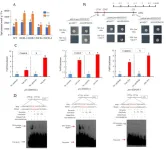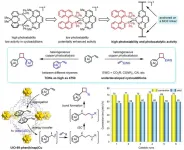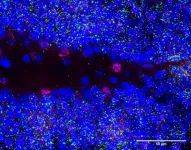(Press-News.org)
Are museums, theaters, and opera houses truly walking the talk when it comes to social and environmental sustainability? The University of Lausanne (UNIL) delved into this pressing question, conducting an international survey with over 200 major cultural organizations. The verdict? While there's significant room for improvement across the spectrum, Anglophone countries lead the charge.
Cultural organizations, with their wide-reaching influence and power to shape narratives and imaginations, are poised to be trailblazers in championing sustainability causes. Recognizing this pivotal role, researchers from UNIL's Department of Geography and Sustainability initiated a comprehensive international survey to assess progress in the realms of social and environmental sustainability.
This global benchmark survey was answered by 206 leading museums, theaters, and opera houses on every continent. Respondents answered questions on diverse criteria, ranging from the inclusiveness and well-being of employees (social aspects) to waste management, energy consumption, catering practices, and carbon impact (environmental considerations).
Published in Sustainability: Science, Practice and Policy, a leading global journal for sustainability, the results underscore a collective need for improvement, with 60% of respondents integrating sustainability into their strategies only in the last five years or less. On average, cultural organizations obtained only 37 out of 100 possible points in the sustainability score, doing better on social sustainability than on environmental sustainability. UNIL professor Martin Müller, spearheading the research, notes a gap between declarations and implementation.
Sustainability champions: a global strategy, a dedicated team and cross-functionality
However, amidst the challenges, the study unveils sustainability champions, 14 in all. A correlation emerges between social and environmental sustainability, emphasizing that those excelling in one area tend also to shine in the other. The top 14 cultural organizations features notable Anglophone organizations like the National Galleries of Scotland and the Sydney Opera House. The study guaranteed the anonymity of the participating institutions, so only the top performers who gave their explicit consent are mentioned. (see the results)
What sets the top-ranking organizations apart is their integration of sustainability into overall strategy and the establishment of dedicated internal groups, so-called green teams, that drive coordinated actions. National contexts and political decisions further influence these endeavors. In England, for instance, publicly funded organizations must report on sustainability, adding an extra layer of accountability, according to co-author Julie Grieshaber. “We’re incredibly proud”, says Anne Lyden, Director General of the National Galleries of Scotland, the most sustainable museum in the study. “We actively support Scotland's aim to reach net-zero before 2045, cutting our carbon footprint by 60% between 2008 and 2022”, she adds. “We understand how important it is to play our part in making a more sustainable future, not just for Scotland but the world.”
Louise Herron, CEO of the Sydney Opera House (first-ranked organization in the study), says: “Sustainability has been part of the Opera House’s DNA since the beginning and over recent years, we’ve been focused on bringing together our efforts to drive social and environmental change, embedding sustainability into our organizational strategy and making it part of everyone’s daily lives. These are urgent challenges that we’re facing, which can only be tackled through coordinated action and as cultural organizations we have a tremendous opportunity to inspire others and bring about change together.”
Establishing a model to follow
Looking ahead, the UNIL researchers aim to extend their impact. Plans include forging a global alliance of cultural organizations committed to sustainability and introducing a label to structure these efforts effectively. Professor Martin Müller, securing substantial funding for a program to promote practical innovation based on scientific research, is poised to be at the forefront of this transformative journey. The future promises not just academic analysis but a concrete path towards a sustainable cultural landscape.
Survey methodology
Questionnaires were completed by 206 organizations from all continents. The data was analysed according to a model comprising three areas: governance (commitment, strategy, implementation, transparency); social (integrity, partnerships, urban integration, community, access, diversity & inclusion, employee well-being, learning & inspiration); and environmental (climate, biodiversity, water, waste, energy, mobility & transport, food & beverage, supply chain).
The organizations included in the survey were selected according to criteria such as their importance to the sector (based on a body of literature), their attractiveness (number of visitors) and the costs invested in their development. The idea was to select deliberately large organizations as the major players in the field.
Reference: M. Müller, J. Grieshaber, How sustainable are cultural organizations? A global benchmark, Sustainability: Science, Practice and Policy, 2024.
An online interactive version of the results will be available on the following website: https://storymaps.arcgis.com/stories/0edddae978c04b3f9e3444fa42301f9b
END
Tomato (Solanum lycopersicum L.) is the most widely cultivated and consumed horticultural crop. At present, saline–alkali is an important abiotic stress source that affects tomato production. Exogenous methyl jasmonate (MeJA) can enhance the resistance of tomatoes to various stress, but its exact mechanism is still unclear.
In January 2024, Horticulture Research published a research entitled by “SlWRKY80-mediated jasmonic acid pathway positively regulates tomato resistance to saline-alkali stress by enhancing spermidine content and stabilizing ...
The impact of abdominal fat on brain health and cognition is generally more pronounced in middle-aged men at high risk of Alzheimer’s disease as opposed to women, according to researchers at Rutgers Health.
In middle-aged individuals with a family history of Alzheimer’s disease, the amount of fat in their abdominal organs (pancreas, liver, and belly fat) is related to their brain volumes and cognitive function, according to the study published in the journal Obesity. The study was written by Sapir Golan Shekhtman, a Ph.D. student at the Joseph Sagol Neuroscience Center at the Sheba Medical Center in Israel and led by ...
ROCKVILLE, Md.— High-fat diets cause obesity in male mice. The underlying mechanism, however, remains controversial. After assessing three contrasting ideas, researchers have determined that the hedonic overdrive model provides the best fit, according to a new study published in the journal Obesity, The Obesity Society’s (TOS) flagship journal.
“Our work provides some direction as to why high-fat/high-carb macronutrient combinations stimulate overconsumption. The study is in mice so we ...
The tone and tuning of musical instruments has the power to manipulate our appreciation of harmony, new research shows. The findings challenge centuries of Western music theory and encourage greater experimentation with instruments from different cultures.
According to the Ancient Greek philosopher Pythagoras, ‘consonance’ – a pleasant-sounding combination of notes – is produced by special relationships between simple numbers such as 3 and 4. More recently, scholars have tried to find psychological explanations, but these ‘integer ratios’ are still credited with making a chord sound beautiful, and deviation from them ...
A new paper in Genome Biology and Evolution, published by Oxford University Press, finds that the link between paternal age and rare congenital disorders is more complex than scientists had previously thought. While researchers have long realized that older fathers are more likely to have children with bone and heart malformations, such as Achondroplasia, Apert, or Noonan syndrome or neurodevelopmental disorders, schizophrenia, and autism, new examination indicates that while the link between some pathogenic mutations increases with paternal age, others do not and may even occur in the father’s testis before sexual maturity.
Delayed fatherhood results in a higher ...
A study into parental smoking and childhood obesity has challenged previous notions by revealing that the links between the two are not confined to a specific socio-economic group.
The data shows a strong correlation between parents who smoke and their children’s consumption of high calorie unhealthy foods and drinks, across social classes.
Using longitudinal data on 5,000 Australian children collected over a 10-year period, the research found those living with parents who smoke, on average, eat less healthy, higher calorie food such as fruit juice, sausages, fries, snacks, full fat milk products, ...
Professor Jian HE, from the Department of Chemistry at The University of Hong Kong (HKU), has spearheaded a research endeavour aimed at revolutionising organic synthesis. His research team has successfully developed a novel heterogeneous copper photocatalyst that enables the efficient formation of cyclobutane rings, a crucial structural element in a vast array of bioactive molecules. Cyclobutane rings are prominently featured in pharmaceuticals, natural products, and various biologically active compounds. By enabling researchers to construct these rings easily and selectively, ...
The success of a deep learning-based network intrusion detection systems (NIDS) relies on large-scale, labeled, realistic traffic. However, automated labeling of realistic traffic, such as by sand-box and rule-based approaches, is prone to errors, which in turn affects deep learning-based NIDS.
To solve the problems, a research team led by Yuefei ZHU published their new research on 15 Feb 2024 in Frontiers of Computer Science co-published by Higher Education Press and Springer Nature.
The team ...
Researchers at the Centre for Genomic Regulation (CRG) reveal that the Snhg11 gene is critical for the function and formation of neurons in the hippocampus. Experiments with mice and human tissues revealed the gene is less active in brains with Down syndrome, potentially contributing to the memory deficits observed in people living with the condition. The findings are published today in the journal Molecular Psychiatry.
Traditionally, much of the focus in genomics has been on protein-coding genes, which in humans constitutes around just 2% of the entire genome. The rest is "dark ...
In The BMJ today, Keisha Bentley-Edwards at Duke University, North Carolina, and colleagues argue that systemic racism and economic inequality are at the root of disparity in covid-19 outcomes and suggest how to distribute resources more equitably.
The article is part of a series that highlights the lessons that can be learned from the US’s covid-19 experience and the actions that are needed to prevent the loss of another million citizens in the next pandemic and improve and protect population health.
"Rather than waiting for the next pandemic to address systemic failures, the ...








